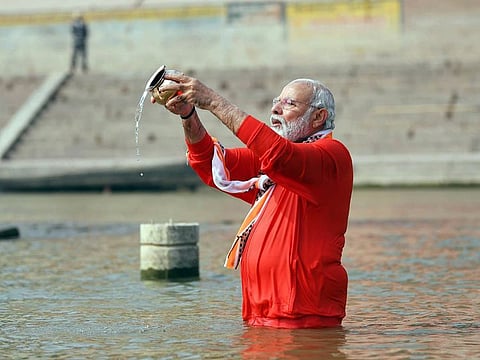UP Elections 2022: Modi’s appeal alone won’t help BJP retain power
Religious polarisation a big factor but not the real issue in India’s most populous state

On Dec. 13, India’s Prime Minister Narendra Modi participated in a spectacular religious ceremony held on a grand scale at Kashi Vishwanath temple in his political constituency of Varanasi in Uttar Pradesh (UP).
The most outstanding thing about the event was that once more Modi identified himself completely as the leader who is here to provide assertive leadership to the causes that touches millions of Hindus.
The message that went out was that there are no ifs and buts about Modi’s or his party’s — Bharatiya Janata Party — fundamental beliefs and identity.
By conducting and publicising a Hindu religious ceremony in one of the most revered and ancient Shiva temples of India, Modi evoked many emotions among followers of Shiva and stirred some controversy among his critics.
To his critics, it was all about timing.
UP, with the third largest economy of all the Indian states and annual budget outlay of over Rs1.2 lakh crores (Rs1.2 trillion or Dh60 billion), is going to polls soon. With more than 14 crore voters, 403 assembly seats and 80 Lok Sabha seats, it is the most important state for any national party to rule Delhi.
Modi's political image
Modi and his party’s future depends on their political image in UP.
All political parties had a clear idea that Modi will put his best foot forward to claim representation of all Hindus while inaugurating a spiritually important landmark for Hindus at Kashi Vishwanath temple. Congress leader Rahul Gandhi anticipated this and presented a counter-narrative a day before in Jaipur.
Rahul said, “I am Hindu, but am not Hindutvavadi. Mahatma Gandhi was a Hindu, but Nathuram Godse who killed the Mahatma was a Hindutvavadi. A Hindu always search for the truth, even at the cost of his life ... While the quest of a Hindu is for ‘Satya’, the Hindutvavadi always look for Satta (power)”.
BJP’s supporters took Rahul’s statement as clear victory of their brand of politics as Rahul had to talk publicly about his own Hindu identity. Many Congressmen, who are keen to gain back credentials among Hindu voters, thought this “course correction” is welcome as 70 to 80% voters in most Indian constituencies are Hindus.
Modi’s efforts to redesign and improve the Hindu pilgrimage centres scattered all over India is a historic plan and will have an impact beyond Uttar Pradesh.
While in UP the ongoing construction of Ram temple and inauguration of Kashi Vishwanath temple’s corridor are certainly being exploited by the BJP to send a message to the Hindu voters, the opposition parties including Congress and Samajwadi Party will make an error of judgement if they buy into the “religious polarisation” debate.
It’s not that BJP won’t benefit from “polarisation on basis of religion” but that’s not the real issue of UP.
Mohammad Sajjad, Professor of History at Aligarh Muslim University, told Gulf News, “In everyday living there is no animosity between Hindus and Muslims in UP like the way it is hyped on social media.”
Law and order situation
After Modi’s two-day visit to Varanasi, I talked to a cross-section of UP society and most of them think that the main election plank will be the handling of “law and order” situation by Yogi Adityanath government in the state.
Voters are sharply divided over the issue of security.
One section of the voters think Chief Minister Yogi Adityanath has handled the state’s law and order issue with an “iron hand”, pleasing the urban middle class but this has created a backlash, too.
Rahul Gandhi may be quibbling about Hindus and Hindutva but for most UP voters — and even for the BJP — the real election plank is law and order.
That is not to say that in the coming UP elections, religious identity will not play a part — as it does in any elections — but the BJP is intelligently dissecting the challenges ahead.
In last UP elections, three parties came out tops: BJP, Samajwadi Party (SP) and Bahujan Samaj Party (BSP) of Dalits led by Mayawati.
The political commentariat in Lucknow feels that the Dalit voters of BSP are likely to desert their loyal platform.
BJP is putting up no holds barred efforts to capture those BSP-loyalists who are looking for options this election season. If the exodus of some 6 to 8% Dalit voters sides with the SP, it will be a blow to the BJP.
A substantial chunk of the Yadavs continues to be loyal to SP while the strategically voting Muslim community is likely to vote SP. Dalit vote, along with Yadavs and Muslims, will make it a formidable combination.
Yogi meantime has coined the slogan “Naya UP for Naya India” (New UP for New India) and taken many steps in changing the fundamentals of governance and economic agenda.
Since it’s not a national election, Yogi’s success will be evaluated on ground zero. On issue of the governance, there is difference of opinion in every district and in every village.
Issues of reverse migration, its impact in villages and the effect of the farmers’ agitation in Western UP and Delhi border are no less important issues.
Above all, the issue of inflation, particularly the high price of fuel, cooking gas and vegetables will be decisive factors.
The magnificent locale of Kashi Vishwanath corridor and Modi’s picture-perfect moves and conduct — while inaugurating it — has strengthened his own standing.
The voters of Uttar Pradesh, while taking into the consideration their caste and communal matrix, will eventually vote for the party that will provide a safe and secure environment in the state.
Sign up for the Daily Briefing
Get the latest news and updates straight to your inbox



